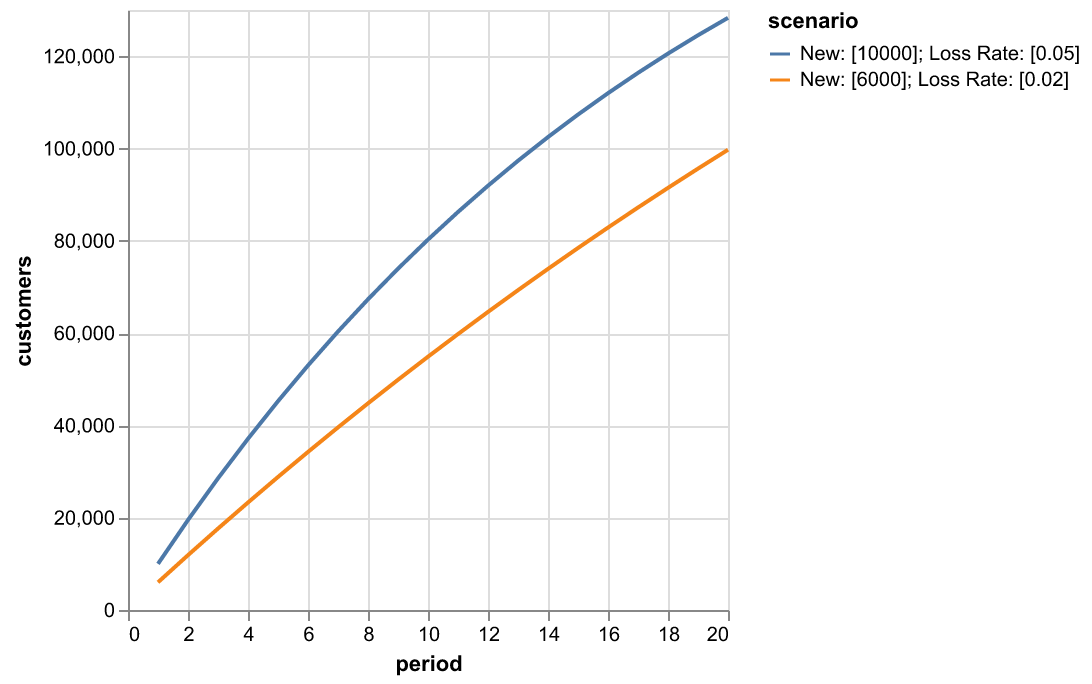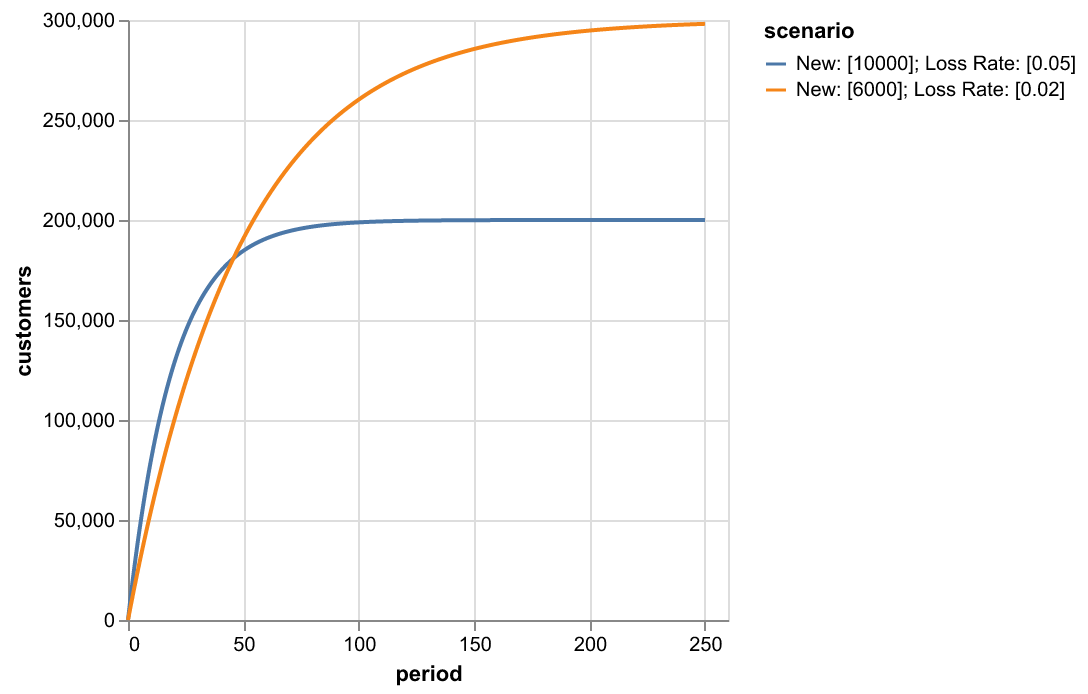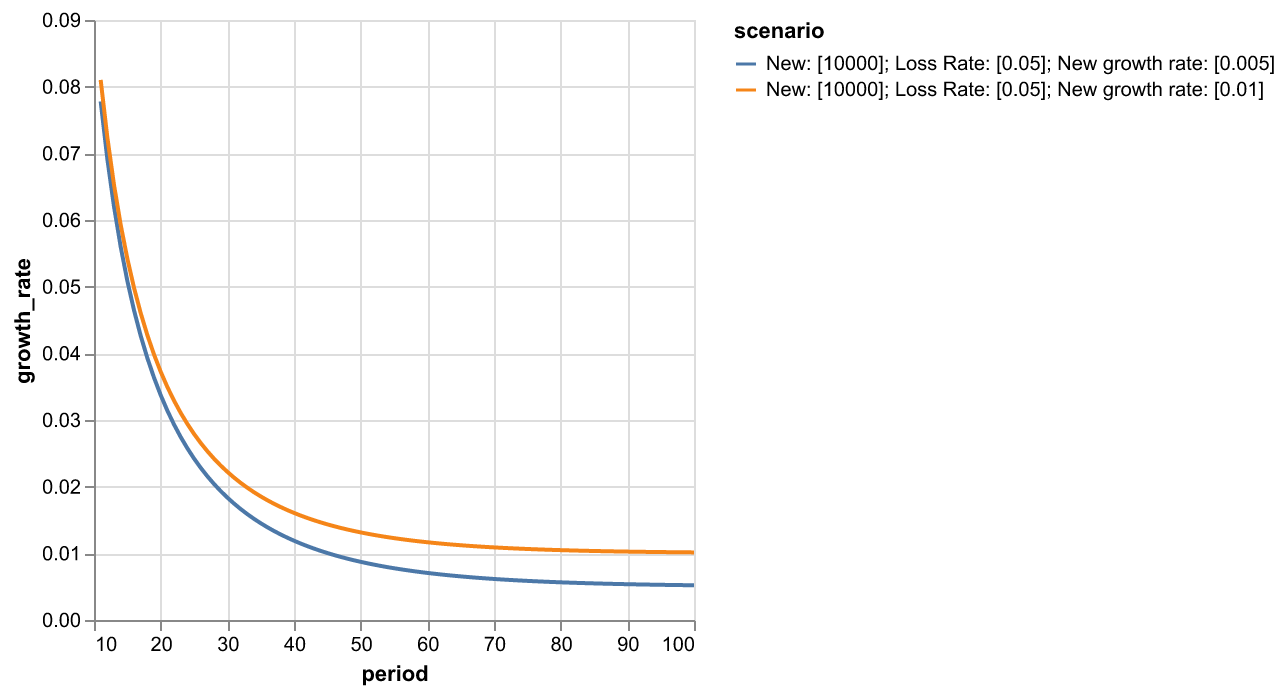A tale of two apps
Imagine you have recently launched a mobile app and you are getting most of your customers organically from the App Store/Play Store. Would you rather get 10,000 new customers per month and lose 5% of your existing customers per month (let’s call this Scenario A) or get 6,000 new customers and lose 2% per month (Scenario B)? In both cases your customer base will be growing but at different rates.
Growth: a foundational belief, poorly understood
For many businesses, growth is of central importance. Indeed, the necessity of never-ending growth is a foundational belief for some1. In this post, I explore the dynamics of growth within the context of a B2C mobile app. This context suggests the presence of Venture Capital. This implies an aggressive approach to growth at any cost with a focus on the very short term2.
In my experience, growth is seldom understood mechanistically and instead is seen to be a result of your efforts and the environment: you tried hard, did a smart thing and lo, there was growth. If there was too little growth it was because you didn’t try hard enough.
There seems to be little understanding of how we might expect growth rates to change over time. Should we expect that the same efforts would result in the same rate of growth at different stages?
Defining growth
The Growth Rate is the change in Customers between periods, divided by the number of Customers in the previous period:
\(Growth_{t} = (Customers_{t} - Customers_{t-1})/Customers_{t-1}\)
Simple growth model: Constant Inflow, Fixed Rate Outflow
In this post, we will consider a very simple model of growth in which over each period we observe:
- A Constant Supply of New Customers.
- Loss of Existing Customers at a Fixed Rate.
This is a gross simplification but it will prove to be useful to illustrate some general properties. As is tradition, we must always invoke George Box when proposing a model:
All models are wrong, but some are useful
We can now expand on our formula:
\(Customers_{t} = Customers_{t-1} + NewCustomers_{t} - LostCustomers_{t}\)
Which yields:
\(Growth_{t} = (NewCustomers_{t} - LostCustomers_{t})/Customers_{t-1}\)
Our loss of existing customers is defined as occurring at a fixed rate:
\(LostCustomers_{t} = Customers_{t - 1} * LossRate\)
Applying the model
Let us apply the above model to our starting example.

For the first twenty months, the results are what one might have guessed: Scenario A yields more customers. However, if we extend the timeline a different picture emerges.

Around 100 months Scenario A ceases to grow. Scenario B continues to grow until around 250 months and results in a much higher total number of customers.
This follows directly from our simple model. Net Growth will be zero when:
\(NewCustomers_{t} = Customers_{t - 1} * LossRate\)
In the case of Scenario A, this occurs when a loss of 5% is equal to 10,000 customers, which in turn occurs when there are 200,000 customers.
An interactive model
I encourage you to experiment with different values in the interactive model to get a feel for the effect of holding one parameter constant and varying the other. For certain examples, growth may only stop after the period displayed but rest assured that it will stop. The interactive model can be accessed directly on Streamlit.
What does this simple model tell us?
The bigger your customer base is, the more customers you will lose every month. As the base of accumulated customers grows, the net customers added in each period get smaller and smaller until it approaches zero. Increasing the inflow at any point will in turn increase the customer base which in turn increases the lost customers. The loss rate has a regulating effect.
This suggests that growth at later stages is much harder than growth at earlier stages.
Some objections to this model:
What about increasing new customers with paid marketing?
The example at the beginning of this post specified organic new customers only because that simplification allowed for representing new customers per month as a constant. Companies may seek to increase new customers per month through paid marketing. If the cost of customer acquisition (CAC) is lower than the customer lifetime value (LTV) then this may be a viable strategy. For many startups, this may not be the case and their ability to sustain this approach will be constrained by their access to funds.
Increasing new customers through paid marketing does not change the fact that at some point the number of customers lost per month will approach the number of new customers. If the marketing budget has to be reduced then the new customers per month will drop below the customers lost per month and the customer base will shrink until new customers and lost customers are equal again.
What if new customers per month increased over time?
One might suggest that a more accurate model would reflect some monthly growth in new customers over time. With this change in place, we see that overall growth doesn’t stop entirely but over time approaches the monthly growth in new customers. I recommend incorporating this into the above equation and doing some exploration as an exercise for the reader.
To pursue this further, we should also consider the expected growth dynamics of new customers per month. Would it be reasonable to expect that a constant increase in this amount could be sustained indefinitely or would the month-to-month growth rate slow over time? And what would be an appropriate way to model this particular kind of growth?

What about X?
This model treats lost customers as forever lost, which is certainly not the case in the real world. Further, revenue isn’t factored in. There may be many more details that are important to a specific application.
It can be very instructive to attempt to develop a model that includes details that you believe are relevant. It is also helpful to communicate your model to others who are familiar with your domain to test your understanding.
Grounding the model in reality
One of the dangers of working with metrics and models is that you can easily mistake the map for the territory and start to think about metrics as something to maximize, to demonstrate growth. The specifics of the product and the customer can start to evaporate.
The two main variables we have considered correspond to:
- People becoming aware of and deciding to install the app.
- The experience of the product.
The easiest thing to do is spend money on paid acquisition. This might have the desired effect in the short term, however, it does nothing to improve the product.
Trying to lower the loss rate requires thinking about the experience of individual customers and considering what is preventing them from remaining as active customers for a longer period. This raises all kinds of important questions about the value proposition, UX, how well the customers understand the product, and how well that is communicated to them both in the product and before they download it. These are all very important things to improve for the sake of the product and the customers. These are often subtler problems that are harder to address but working on them attempts to create a better, more valuable product for your customers.
A Tale of two apps revisited
Which of our two scenarios should you choose? One may be tempted to choose Scenario B because it has greater potential over a long period. Implicit in the model above is the possibility that in both scenarios the product continues to exist indefinitely, which of course isn’t true.
As with many things, the answer will depend on your context.
Further reading
The Model Thinker by Scott E. Page.
Thinking in Systems by Donella H. Meadows.
-
This foundational belief deserves serious scrutiny. Some amount of growth may be necessary for a business to become viable but should it continue forever? This post is merely about the dynamics of growth instead of the merits of the belief in growth. For further and broader reading on the topic consider reading Limits to Growth by Donella H. Meadows, Dennis L. Meadows and Jørgen Randers, ↩︎
-
Questions of the long-term prospects for a business seem to be of little concern to VCs in particular. From their perspective, the idea only has to appear to hold water until a liquidity event, after which it becomes somebody else’s problem. ↩︎